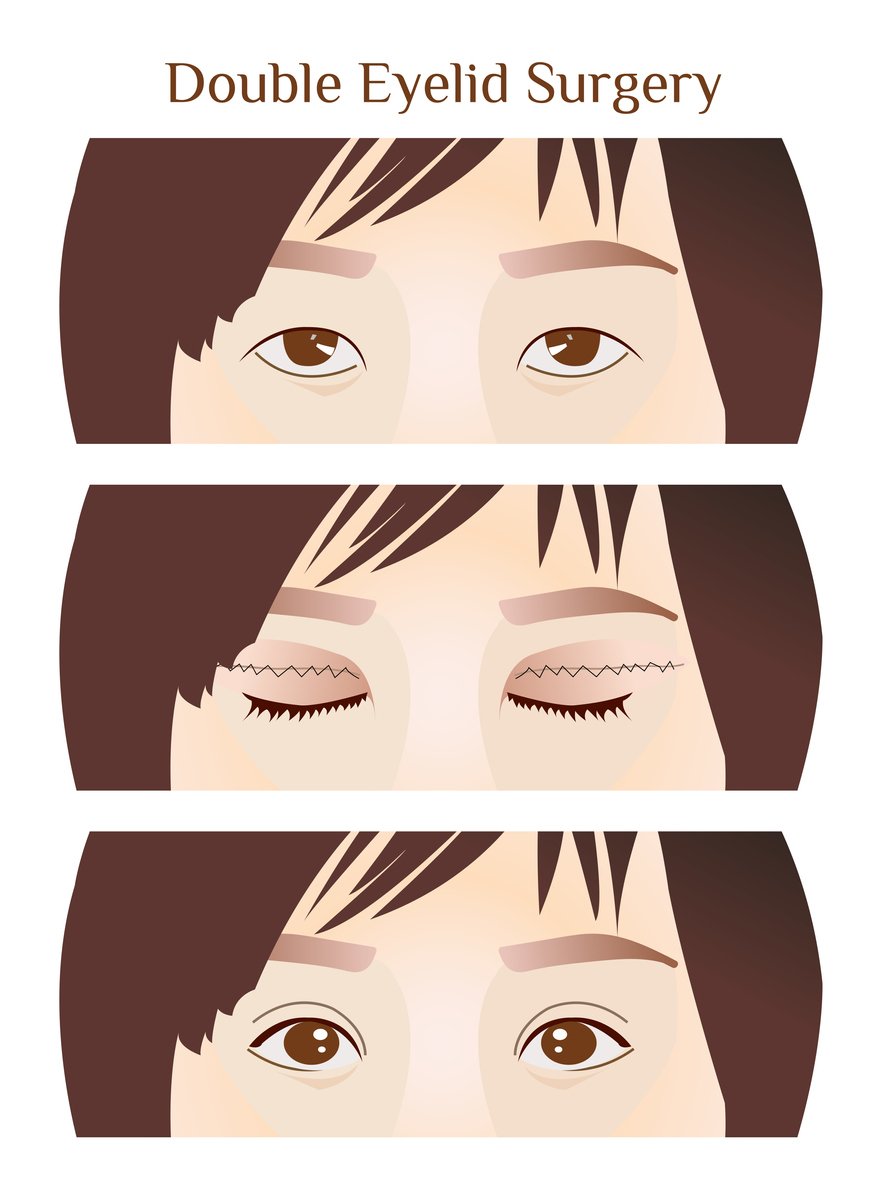Specialist Plastic Surgeon
PhD FRACS
AHPRA MED0001189889
If having a double-folded eyelid concerns you this feature can be can be addressed to assist the eyes to appear more open.
Many people inherit what’s called a double eyelid. On some faces, this can lead to an appearance that patients describe as ‘sleepy-looking facial expression” or the appearance of “smaller-looking eyes”.
The reason is that there is no distinguishable eyelid crease. Without an eyelid crease there is a ‘free fall’ of the excess eyelid skin that folds over itself. This results in the eyelid skin covering more of the eyes than the patient desires.
When you are young, it is not a medical concern, but a genetic trait and an aesthetic concern for some people. As you get older, the ‘free fall’ of the excess skin continues and may impact your vision when it becomes a medical issue. In both cases plastic surgery can help.

Lack of double fold in the upper eyelid
Epicanthal (over-hanging) fold in
the corner of the eye
Upper Eyelid Blepharoplasty
Precise suture techniques
create a double eyelid fold and the eye looks bigger
Epicanthal fold is
corrected by redistribution of skin.
Eye looks bigger.
A Double-Eyelid Blepharoplasty creates an eyelid crease that results in a more open-eyed expression to enhance the overall facial appearance in patients with suitable anatomy for the procedure.
Technically, it involves adjusting and excising the skin above the eyelid, surgically creating a single crease, without disrupting important eyelid functions such as blinking and closing your eyes. The optimal surgery outcome is removal of drooping eyelid skin and defining a single crease. This helps open up the eyes, surgically treating the double-fold eye lid appearance.
Double eyelid surgery should be performed in a licensed facility. It usually takes between 1.5 - 2 hours. I recommend an overnight stay in hospital.
OUR PROCESS
You will generally see Dr Somia 3 times before your surgery. If you prefer one of these consultations can be held via telehealth. Two consultations are required by law before a date for surgery is scheduled. This is to allow you plenty of time to ask questions and feel comfortable about the procedure. Your third consultation will assist us to prepare you for your surgery (ie paperwork, pre-operative testing).
PROCEDURE DETAILS
The surgery takes approximately 1.5 hours to 2.5 hours depending on the procedure recommended and requires an overnight stay in hospital. Our fees include specialist plastic surgeon, specialist anaesthetist, fully accredited hospital theatre, accommodation and 6 months aftercare. A formal estimate will be provided after you have discussed your goals and what is possible to achieve them with Dr Somia.
RECOVERY
Each patient recovers at a different rate and anothers recovery should not be compared with yours.
Generally, initial recovery from swelling and bruising is approximately 3-4 weeks. A return to normal activities can usually be expected after 6 weeks. Full results can be expected 3-6 months after.
You can return to work when you feel well and if your employer has lighter duties for you and will allow you to take time to rest and move around. Most patients take 2-3 weeks off work if they work in an office context. Patients working outdoors or in a physical capacity may need to take up to 6 weeks off work whilst they recover. Talk to us about your specific occupation and surgery.
You can drive when the anaesthetic has worn off, your vision is clear, and you are pain free getting in and out of the care and whilst performing an emergency stop. You should check your vehicle insurance policy for their requirements in this situation.
RISKS
All surgery carries risks. When travelling overseas on a plane whilst the expectation is a safe journey and arrival, it is understood things could go wrong. The choice of the airline based on safety record and flight path are important elements in determining risk. Similarly, for your surgery, the experience and expertise of your Surgeon, the skill of your anaesthetist and the standard of the hospital will determine the risk. Risks, both general and specific, will be discussed during your consultations and written information will be provided for you to take home.
General risks include pneumonia, deep venous thrombosis and pulmonary embolism, stroke, heart attack, allergies, awareness, death, bleeding, infection, sensation change, haematoma and seroma, skin contour irregularities, damage to deeper structures, firmness, delayed healing and tissue death, exposed sutures, dog ears or additional skin golds, dressing issues, asymmetry, scars, lymphoedema and unsatisfactory results.
Risks specific to Blepharoplasty (Eyelid) surgery are: injury to the eye globe, need for extra tissue, loss of vision, changes to tear secretion, conjunctival oedema and chemosis, exposed sutures, upper eyelid malposition, difficulty closing the upper eyelid and corneal exposure, lower eyelid malposition and eyelash loss.
BEFORE AND AFTER PHOTOGRAPHY
Our practice privacy policy prevents sharing patient before and afters online. Indicative before and after photos can be viewed during your consultation.
SUBSCRIBE TO NAVEEN'S BLOG
Receive notifications new articles are published.
CONTACT
Bondi Junction
Westfield Tower 2,
Suite 1305, 101 Grafton St,
Bondi Junction NSW 2022
info@naveensomia.com.au
02 9387 2110 I 0438 939 962
CONTACT
Bella Vista
Suite 212, Level 2, 10 Norbrik Dr
Bella Vista NSW 2153
info@naveensomia.com.au
02 9387 2110 I 0438 939 962